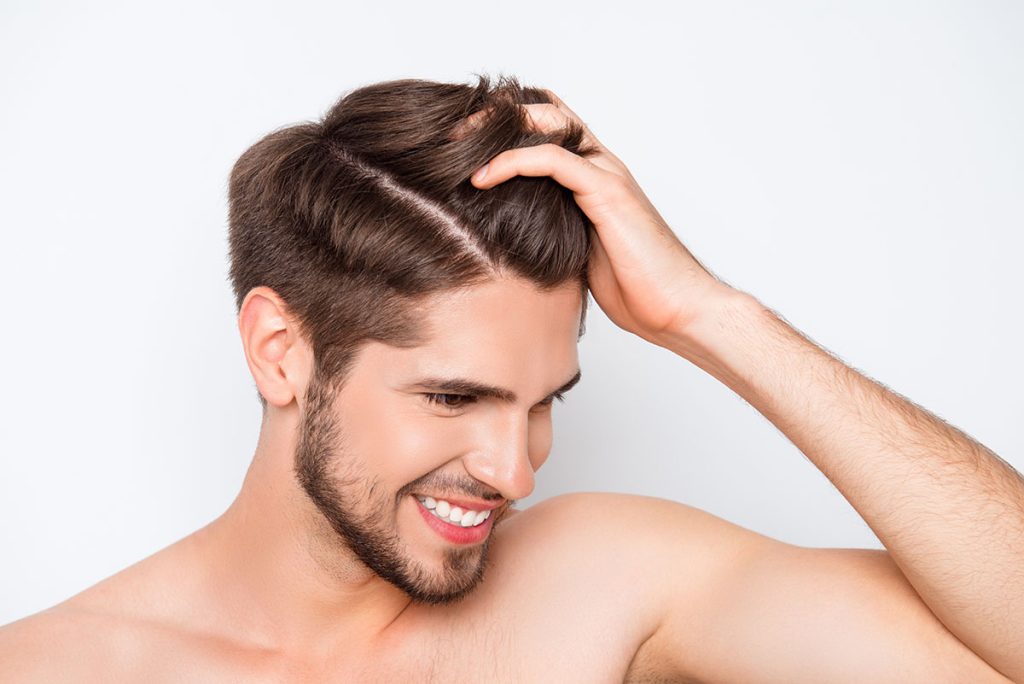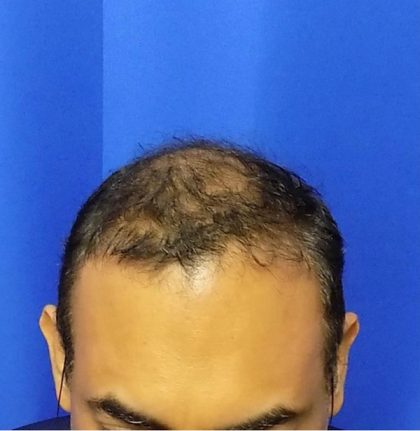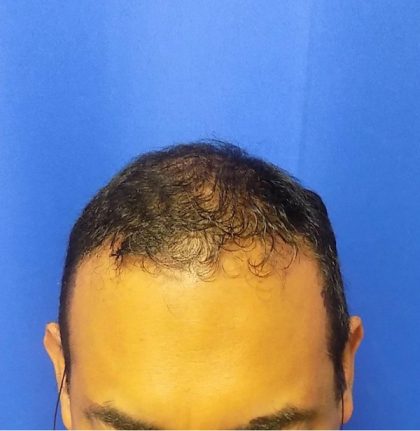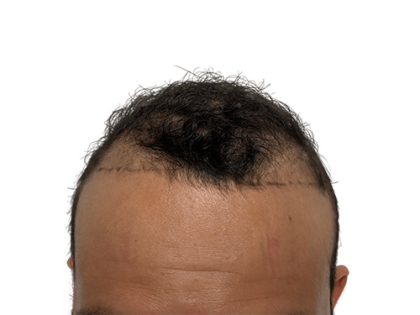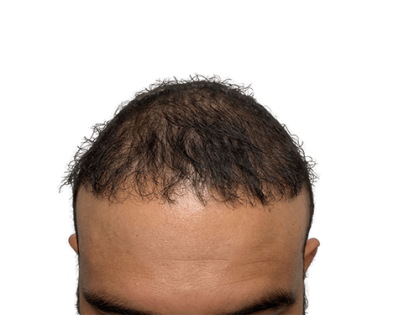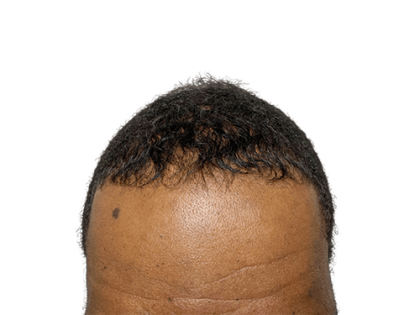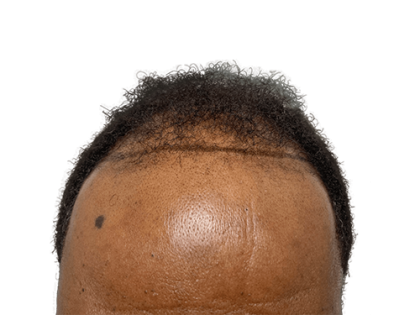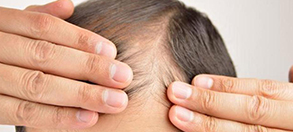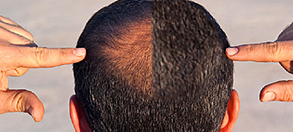Body hair transplantation (BHT), or body to scalp hair transplantation, is a method that uses donor hair from another area of the body, rather than or in addition to using scalp donor, to achieve the desired results. As an alternative to the standard Follicular Unit Extraction (FUE) harvest areas, a BHT procedure can take hair from the beard, abdomen, chest, or elsewhere, provided the hair is suitable and the graft quality is high enough to warrant grafting.
More advanced hair loss can be difficult to treat. As there is very little donor hair for a surgeon to work with, and very few areas of the scalp it can be harvested from, patients may find themselves with limited hair restoration options. However, with BHT, there is hope for a fuller head of hair. BHT follows nearly the same minimally-invasive steps as standard FUE, the only difference being the donor hair sites and the local anesthesia techniques. This method is suitable for patients with very little hair on the scalp for grafts, such as those with more severe cases of androgenetic alopecia.
Dr. Goran Jezic is Houston’s premier hair transplantation surgeon, helping patients across the state with varying levels of hair loss to regain hair density and confidence. He uses the latest in modern FUE techniques, and welcomes patients to speak to him about the benefits of body to scalp hair transplantation. To schedule a consultation at Houston Hair Transplant Center, use our quick inquiry form on our website, or call Houston, TX or Austin, TX at (713) 864-2300.
Before and After Photos
Stages of Hair Loss
Pattern hair loss is the most common reason people of both sexes lose their hair after puberty.(1) It typically shows in three distinct ways,
- Progressive hair thinning (at the hairline and crown for men, diffuse thinning for women)
- Physical miniaturization of hair follicles in the affected area(s)
- Progressive thinning of hair density through shedding in the affected area(s)
Androgenetic alopecia develops in a predictable way, regardless of the rate of loss. Therefore, recession and thinning caused by hormone changes can be classified according to severity. Hair physicians use the Hamilton-Norwood Scale to measure the extent of baldness in an individual.
Hamilton-Norwood Scale.
The Hamilton-Norwood classification system measures the degree of hair loss in an individual.(1)
- Grade I – Standard frontal hairline position with no significant thinning.
- Grade II – Symmetrical hairline recession in the frontal and temporal areas. Possible widow’s peak.
- Grade III – Thinning hairline with thinning in the front through to mid-scalp. Possible thinning at the back of the head.
- Grade IV – Receding hairline with thinning in the front, top, and mid-scalp. Possible thinning at the back of the head.
- Grade V – Absent hairline from the top of the head to the crown. Hair thinning throughout the scalp.
- Grade VI – Significant thinning from front to crown. Very little hair at the top of the head. Some people may choose to comb over remaining hair from the sides.
- Grade VII – Significant hair loss. Loss of all hair except for the sides of the head. Some people may choose to comb over remaining hair from the sides.
The timeline for hair loss varies from person to person, however, there is usually a steep drop-off after 40 years of age. This is reflected in data obtained from hair loss studies. Research shows that roughly 2 in 10 men between the ages of 30-35 have grade VI hair loss, while over 6 in 10 have grade VI loss after age 41.(2)
The usual areas for graft harvesting are the back of the head or the sides. However, patients suffering from more severe hair loss may not be afforded these options. This is where BHT may be most useful.
How Can BHT Help?
Terminal hair is the type of hair on your scalp. It is also the type of hair found on many other parts of the body, and the hair needed in a transplantation procedure. Body to scalp hair grafts can be harvested from various areas of the body, including the following:
- Arms
- Back
- Beard
- Chest
- Chin Region
- Lower Abdomen
- Thigh
The basic FUE concepts are the same, regardless of donor hair site. Dr. Jezic and the team of specialists harvest groups of hair follicles from the donor site called follicular units, which are then prepared and re-implanted into the area of hair loss. There are robotic options for hair transplantation, such as the ATERA or NeoGraft systems, however, due to the nature of BHT, using a more manually operated device such as the WAW is required to obtain donor grafts. The device is more efficient for lowering transection on body hair extractions. A modified punch extraction technique, alongside more specialized pulling is required for extraction of these grafts.(3)
Special Considerations
There is often a higher transection (damage) rate with follicular units harvested from non-scalp areas. The hair may also be farther spaced, and be curlier, thicker, or thinner than the hair on the scalp. Body hair also lies at a much closer angle to the skin than hair from the scalp. Therefore, special considerations must be given to body hair extraction technique.
In most cases, beard hair is preferred as follicular units are more dense and hair is of a suitable quality. Chest or back hair are usually good alternatives if beard hair is not harvestable, or the client simply requires more hair.
Find out more about FUE and other hair restoration techniques by reading Dr. Jezic’s blog.
Candidates for Body to Scalp Hair Transplants
BHT is for patients with more serious hair loss, for whom standard FUE would be ineffective. It may be used in Grade V and above cases, after a thorough evaluation that rules out scalp donor sites based on hair density and quality by Dr. Jezic. Depending on the patient, it can be used in conjunction with other FUE techniques, or as a standalone procedure.(4)
Good Candidates for Body to Scalp Technique
- Patients age 25 and above
- Patients who lack suitable donor hair on the scalp
- Patients with severe pattern hair loss
- Patient with smaller patches of severe hair loss
- Patients already undergoing standard FUE
- Patients with realistic expectations for their results
Personal Consultation
Dr. Jezic will take the time to perform a rigorous physical examination of hair quality and quantity at your personal consultation. You will have the opportunity to explain how your hair loss is affecting you, and you will be able to show Dr. Jezic the areas of your scalp that cause you the most concern.
Body to scalp hair transplantation can use hair from virtually any part of the body, however, some hair will be more suited to transplantation than others. After ruling out hair, or recognition of a graft shortage from the scalp, Dr. Jezic will assess other areas of the body for harvesting suitability. He will pay particular attention to beard hair and chest hair, before addressing other areas of the body such as the back, arms, legs, and pubic region.
After he has completed his evaluation, he will inform you of the best way forward for your hair transplantation procedure and draw up a personalized plan that fits your individual requirements.
Arrange your meeting with Dr. Jezic at Houston Hair Transplantation Center in Houston or Austin by calling us at (713) 864-2300 or by completing a simple online form briefly detailing your request.
Great Results with BHT
Body hair transplantation can be used to restore thicker hair to the scalp, or even to another part of the body, such as the beard or eyebrows. You will have a valuable opportunity to explore your hair restoration options with Dr. Jezic, so be sure to make a list of questions to bring to your consultation if you are curious about the benefits of body to scalp transplantation. At Houston Hair Transplant Center, our hair restoration experts will help you find the best pathway to a thicker head of hair!
Cost of Body to Scalp Hair Transplants in Houston, TX
Body to scalp treatment plans are highly individualized. Hair transplantation involves multiple factors that can affect the cost of the procedure, including the area of the body selected as a donor site, and the number of follicular units required for the best results. Our practice uses state-of-the-art hair restoration systems and a personalized approach to ensure you get the most out of your experience. Contact our Houston or Austin offices at (713) 864-2300 or complete a short online form to book your personal consultation at Houston Hair Transplant Center.
FAQ
Can I get a hair transplant if I have severe baldness?
In many cases of severe hair loss, an experienced hair restoration physician can obtain hair grafts from a site other than your scalp, such as the chest, abdomen, or back. Realistic expectations are critical, as you can only accomplish what your body can put forward.
How long does the body to scalp hair transplantation process take?
A body to scalp hair transplantation procedure will vary depending on the amount of hair harvested from the body and how many areas are required for harvesting. Time of the case can also shift based on patient tolerance to anesthesia. In some cases, BHT FUE’s may take longer to complete and in extreme circumstances, may be performed over two days. Schedule a consultation with a hair restoration specialist for a thorough physical examination to gain more information.
How long does a body to scalp donor site take to heal?
References
- Gupta M, Mysore V. Classifications of patterned hair loss: a review. Journal of Cutaneous and Aesthetic Surgery. 2016;9(1):3. doi:https://doi.org/10.4103/0974-2077.178536
- Shankar KrupaDS, Chakravarthi M, Shilpakar R. Male androgenetic alopecia: Population-based study in 1,005 subjects. International Journal of Trichology. 2009;1(2):131. doi:https://doi.org/10.4103/0974-7753.58556
- Poswal A. Expanding needle concept for better extraction of body hair grafts. Indian Journal of Dermatology. 2013;58(3):240. doi:https://doi.org/10.4103/0019-5154.110845
- Savant S, Saxena K. Body to scalp: Evolving trends in body hair transplantation. Indian Dermatology Online Journal. 2017;8(3):167. doi:https://doi.org/10.4103/idoj.idoj_283_16
